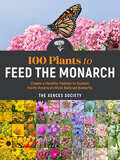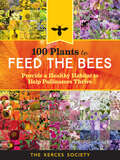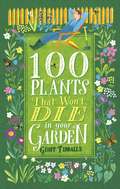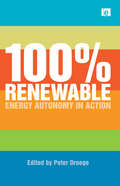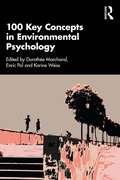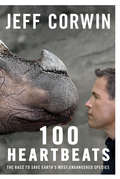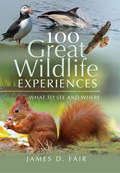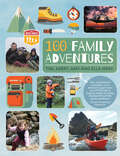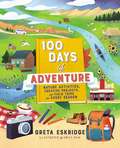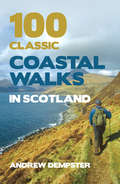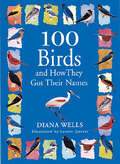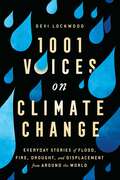- Table View
- List View
The 100% Solution: A Plan for Solving Climate Change
by Solomon Goldstein-Rose"At last--a global plan that actually adds up."--James Hansen, former director, NASA Goddard Institute for Space StudiesThe world must reach negative greenhouse gas emissions by 2050 to avoid the most catastrophic effects of climate change. Yet no single plan has addressed the full scope of the problem--until now. In The 100% Solution, Solomon Goldstein-Rose--a leading millennial climate activist and a former Massachusetts state representative--makes clear what needs to happen to hit the 2050 target: the manufacturing booms we must spur, the moonshot projects we must fund, the amount of CO2 we'll have to sequester from the atmosphere, and much more. Most importantly, he shows us the more prosperous and equitable world we can build by uniting the efforts of activists, industries, governments, scientists, and voters to get the job done. This is the guide we've been waiting for. As calls for a WWII-scale mobilization intensify--especially among youth activists--this fully illustrated, action-oriented book arms us with specific demands, sets the stakes for what our leaders must achieve, and proves that with this level of comprehensive thinking we can still take back our future.
100 Plants to Feed the Monarch: Create a Healthy Habitat to Sustain North America's Most Beloved Butterfly
by The Xerces SocietyThe plight of the monarch butterfly has captured public attention and sparked widespread interest in helping to save their dwindling populations. In this in-depth portrait of the monarch butterfly—covering its life cycle, its remarkable relationship with milkweed, its extraordinary migration, and the threats it now faces due to habitat loss and climate change—detailed instructions on how to design and create monarch-friendly landscapes are enriched by guidance on observing and understanding butterfly behavior and habits. Following the model of their previous best-selling book, 100 Plants to Feed the Bees, the Xerces Society provides at-a-glance profiles of the plant species that provide monarchs with nourishment. The plants, which are all commercially available, range from dozens of species of milkweed—the only food of monarch caterpillars—to numerous flowering plants, shrubs, and trees that provide nectar for the adult butterfly, including those that bloom in late season and sustain monarchs in their great migration. Gorgeous photographs of monarchs and plants, plus illustrations, maps, and garden plans, make this a visually engaging guide.
100 Plants to Feed the Bees: Provide a Healthy Habitat to Help Pollinators Thrive
by The Xerces SocietyThe international bee crisis is threatening our global food supply, but this user-friendly field guide shows what you can do to help protect our pollinators. The Xerces Society for Invertebrate Conservation offers browsable profiles of 100 common flowers, herbs, shrubs, and trees that support bees, butterflies, moths, and hummingbirds. The recommendations are simple: pick the right plants for pollinators, protect them from pesticides, and provide abundant blooms throughout the growing season by mixing perennials with herbs and annuals! 100 Plants to Feed the Bees will empower homeowners, landscapers, apartment dwellers — anyone with a scrap of yard or a window box — to protect our pollinators.
100 Plants That Won't Die in Your Garden
by Geoff TibballsStocking a garden with plants can be an expensive business, so there are few things more frustrating than when the prized specimen for which you have paid a king's ransom either online or at a garden centre shrivels up and dies within a year or so of purchase. If you can prove that the plant was half-dead when it arrived, you may able to obtain a refund from some online retailers, but for the most part you have to put it down to experience and make a firm mental note not to buy fussy plants in future.The problem is that many websites and catalogues claim that everything they stock is easy to grow. Herbaceous perennials are a particular minefield. Too often you are told that a certain plant 'will come back year after year' without fail when in reality it is either so tender that the only chance of it surviving an average British winter is in a greenhouse or it is a short-lived perennial that is unlikely to flourish beyond two years anyway - and even then only if the local slugs and snails are on a diet. This book cuts through the horticultural sales pitches by listing 100 plants which, for little care beyond the essential watering at planting time, can reliably be expected to thrive in just about any garden. These plants are all but indestructible - pests give them a wide berth, they will prosper in any reasonable garden soil and will withstand anything that the UK climate throws at them. Divided into sections for shrubs, conifers, climbers, perennials, grasses, annuals, alpines and bulbs and with each entry having a Value For Money (VFM) rating out of 10, this easy-to-use guide will prove invaluable not only for the new gardener but also for old hands who are fed up with wasting time and money on plants that all too rapidly lose the will to live. With these suggestions, you can be assured of year-round colour and interest in your garden for the minimum of effort.
100 Plants That Won't Die in Your Garden
by Geoff TibballsStocking a garden with plants can be an expensive business, so there are few things more frustrating than when the prized specimen for which you have paid a king's ransom either online or at a garden centre shrivels up and dies within a year or so of purchase. If you can prove that the plant was half-dead when it arrived, you may able to obtain a refund from some online retailers, but for the most part you have to put it down to experience and make a firm mental note not to buy fussy plants in future.The problem is that many websites and catalogues claim that everything they stock is easy to grow. Herbaceous perennials are a particular minefield. Too often you are told that a certain plant 'will come back year after year' without fail when in reality it is either so tender that the only chance of it surviving an average British winter is in a greenhouse or it is a short-lived perennial that is unlikely to flourish beyond two years anyway - and even then only if the local slugs and snails are on a diet. This book cuts through the horticultural sales pitches by listing 100 plants which, for little care beyond the essential watering at planting time, can reliably be expected to thrive in just about any garden. These plants are all but indestructible - pests give them a wide berth, they will prosper in any reasonable garden soil and will withstand anything that the UK climate throws at them. Divided into sections for shrubs, conifers, climbers, perennials, grasses, annuals, alpines and bulbs and with each entry having a Value For Money (VFM) rating out of 10, this easy-to-use guide will prove invaluable not only for the new gardener but also for old hands who are fed up with wasting time and money on plants that all too rapidly lose the will to live. With these suggestions, you can be assured of year-round colour and interest in your garden for the minimum of effort.
100 Per Cent Renewable: Energy Autonomy in Action
by Peter DroegeThe greatest challenge of our time is to build a world based on the sustainable use of renewable power. Our massive dependence on fossil fuels has upset the very climatic system that made human evolution possible. The global economy and its financial system are in jeopardy, running hot on overtly cheap yet increasingly costly and fast depleting oil. A 100% renewable world is seen by many as an impossible dream in anything but the very long term. But not only do a growing number of initiatives and plans dare to make the change but many have already achieved it. This rich collection presents a series of pioneering efforts and their champions, and the paths to their successes. Ranging from initiatives by individuals to visions for companies, communities and entire countries, it defeats tired economic and technical counter-arguments, showing how the schemes featured not only can and do work but do so economically and with available technology. The book is introduced by incisive writing by Peter Droege, explaining the challenges and framing a roadmap towards a 100% renewable reality.
100 Key Concepts in Environmental Psychology
by Dorothée MarchandThis accessible book defines 100 key concepts, ideas and processes in Environmental Psychology to provide an introductory reference work that brings together research and theory in a bite-size format. With contributions from leading figures within Environmental Psychology, each concept is clearly defined and explained within the context of issues around the environment, sustainability, climate change, nature and architecture. This book considers the involvement of psychological, physiological and social processes to understand the mechanisms that explain and contribute to the evolution of behavior and attitudes that relate to our relationship with the environment. Concepts covered include biodiversity, eco-anxiety, place identity, sustainable behaviour, climate justice and environmental attitudes. By integrating ideas from different disciplinary orientations in the field of Environmental Psychology, this book allows for a better understanding of the processes related to the individual-environment relationship, as well as the applications that they allow for in various fields of intervention. This is essential reading for students and researchers in Environmental Psychology, Sustainability Studies, Architecture and Built Environment Studies and related fields.
100 Heartbeats: The Race to Save Earth's Most Endangered Species
by Jeff CorwinIt's no secret that our planet—and the delicate web of ecosystems that comprise it—is in crisis. Environmental threats such as climate change, pollution, habitat loss, and land degradation threaten the survival of thousands of plant and animal species each day. In 100 Heartbeats, conservationist and television host Jeff Corwin provides an urgent, palpable portrait of the wildlife that is suffering in silence and teetering on the brink of extinction. From the forests slipping away beneath the stealthy paws of the Florida panther, to the giant panda's plight to climb ever higher in the mountains of China in search of sustenance, to the brutal poaching tactics that have devastated Africa's rhinoceros and elephant populations, Corwin takes readers on a global tour to witness firsthand the critical state of our natural world. Along the way, he shares inspiring stories of battles being waged and won in defense of the earth's most threatened creatures by the conservationists on the front lines. These stories of hope and progress underscore an important message: Our own survival, as well as that of the world's wildlife, is in our hands. The race to save the planet's most endangered wildlife is under way. Every heartbeat matters.
100 Great Wildlife Experiences: What to See and Where
by James D. Fair&“From flowers to sharks, with birds, butterflies and bats in between, this book is the perfect companion when planning a trip in the UK.&” —Random Things Through My Letterbox There are many guides to the world&’s great wildlife experiences, but the UK is neglected and this book sets out to remedy this. 100 Great Wildlife Experiences really takes in all the amazing things to see and do in the UK, in all seasons—because winter, of course, can be just as good as summer or spring. The 100 experiences to be had here in the UK are placed in categories such as &“Best for Families,&” &“Best for Couples,&” &“Best on a Budget&” and so on. Covering every county in the country, this book is useful for people who want to explore their local area and surrounding counties, and for those in need of an insightful guide to take on their travels. &“Natural history writer James Fair takes us on a journey around the British Isles, showing us glorious places to visit and sights to see . . . from nightjars in Suffolk to wildcats in Scotland.&” —WI Life &“This beautiful book lists and illustrates the brilliant wildlife parks in the UK, with fantastic photos and summaries of the rich and varied variety of places to visit in order to enjoy the wide variety of wildlife native to our country, as well as the summer and winter visitors. A thoroughly superb book showcasing our national places of interest.&” —Books Monthly
100 Family Adventures
by Tim Meek Kerry Meek Amy Meek Ella MeekAdventure is out there – you just have to go and find it!Childhood obesity is increasing year on year. Happiness and well-being levels in children are on the decline too. Children spend less time outside and more time in front of screens: computers, phones, games, television.100 Family Adventures provides a valuable resource bank of tried and tested outdoor activities to enjoy with children, swapping 'screen time' for 'green time'. Particularly inspiring for people who want to get started, but don’t know how, the book shows how any family, anywhere in the country, can enjoy time together outdoors.Activities are grouped into themes: Woodland, Water, Close to Home, Hills and Mountains, Exploring, By the Sea, Extreme Weather. Within each section is a range in difficulty, from making a rope swing to scrambling up a stream, from spending a day without electricity to going on a charity bike ride, from exploring a rockpool to camping on an uninhabited island.Packed with inspiring photos, sensible but enthusiastic instructions from parents Tim and Kerry combine with remarks and advice (and jokes!) from children Amy and Ella.'The adventure ambassadors our current generation of cotton-wool kids urgently need' Daily Telegraph
100 Days of Adventure: Nature Activities, Creative Projects, and Field Trips for Every Season
by Greta EskridgeTurn off the screen and turn on the creativity as second-generation homeschooling mom Greta Eskridge shares 100 hands-on learning activities for kids that will connect and enrich your family through adventures, small and big.Have a meteor slumber party, attend a symphony concert, take a hike in the rain, preserve colorful fall leaves, and make nettle pesto as children explore a love of nature and venture into the great, wide, real world. From backyard bugs to farmer's market veggies, children will unplug from electronics; explore the world; and learn about nature, art, music, and themselves through STEAM projects and new experiences.100 Days of Adventure will spark curiosity in 6- to 10-year-olds withIndoor and outdoor seasonal activities, projects, experiments, crafts, recipes, and field tripsFree and low-cost activities, with options for different kinds of groups and locationsStep-by-step directions, nature journal prompts, tips, and checklistsBeautiful photos and helpful illustrationsChildren can bond with parents and siblings, learn new skills with individual investigations, or explore with friends in an educational or homeschool group with this full-color activity book. Also included is a note to parents with encouraging start-here guidance on growing a family culture of curiosity and adventure.Whether your family is looking for fun activities for school breaks at home, road trip vacations, or everyday ways to learn together, this collection of interactive educational activities will help your kids get creative, get into nature, and get closer to each other.Don't miss Greta's essential guide for parents on building a connected and loving family through exploration, Adventuring Together: How to Create Connections and Make Lasting Memories with Your Kids.
100 Classic Coastal Walks in Scotland: the essential practical guide to experiencing Scotland's truly dramatic, extensive and ever-varying coastline on foot
by Andrew DempsterIf you are keen to explore the six thousand miles of coastline that Scotland has to offer, then this is the perfect guide for you. Complete with maps and illustrations and covering walks ranging from gentle strolls, family friendly outings and full-scale hikes, this is the perfect handbook for any Scottish adventure!'An invaluable accessory to the boots and the backpack' -- Daily Record'This selection of day trips, including maps and useful information, is a welcome sight' -- Scottish Field'Superb book with some great walks in it - ideal for new and old hikers alike' -- ***** Reader review'Excellent and very informative' -- ***** Reader review'Brilliant - very impressed, nicely laid out and nice maps too' -- ***** Reader review**************************************************************************************Scotland and its islands encompass more than 10,000 miles of breath-taking coastline. The 100 routes outlined by Andrew Dempster in this essential guide take in the quaint fishing ports, long sun-bleached strands and vast golf links of the east coast; the grand Gothic cliffs, natural arches and storm-tossed sea-stacks that comprise much of the fractured edge of the Atlantic; the kaleidoscopic wildflower carpet of the Western Isles machair; the romantic castles and Clearance settlements of Skye; and myriad idyllic secluded beaches and awe-inspiring clifftop vantage points.This unique guide covers the whole spectrum, from short hour-long beach strolls to serious full-day hikes that require mountain gear and total commitment.Compiled in a user-friendly format, containing maps and illustrations throughout, 100 Classic Coastal Walks in Scotland provides a wealth of walking possibilities for anyone with an interest in outdoor pursuits, with many of the walks also suitable for children.Book that staycation now!
100 Birds and How They Got Their Names
by Lauren Jarrett Diana WellsHow did cranes come to symbolize matrimonial happiness? Why were magpies the only creatures that would not go inside Noah's Ark? Birds and bird imagery are integral parts of our language and culture. With her remarkable ability to dig up curious and captivating facts, Diana Wells hatches a treat for active birders and armchair enthusiasts alike. Meet the intrepid adventurers and naturalists who risked their lives to describe and name new birds. Learn the mythical stories of the gods and goddess associated with bird names. Explore the avian emblems used by our greatest writers--from Coleridge's albatross in "The Ancient Mariner" to Poe's raven. A sampling of the bird lore you'll find inside: Benjamin Franklin didn't want the bald eagle on our National Seal because of its "bad moral character," (it steals from other birds); he lobbied for the turkey instead. Chaffinches, whose Latin name means "unmarried," are called "bachelor birds" because they congregate in flocks of one gender. Since mockingbirds mimic speech, some Native American tribes fed mockingbird hearts to their children, believing it helped them learn language. A group of starlings is called a murmuration because they chatter so when they roost in the thousands. Organized alphabetically, each of these bird tales is accompanied by a two-color line drawing. Dip into 100 Birds and you'll never look at a sparrow, an ostrich, or a wren in quite the same way.
10,000 Garden Questions Answered by 20 Experts
by Marjorie J. DietzAnswers on: soils, fertilizers, landscaping, ornamental plants, trees, shrubs, vines, bulbs, tubers, corms, roses, perennials, annuals, biennials, lawns, vegetables, fruits, house plants, weeds, etc.
1,001 Voices on Climate Change: Everyday Stories of Flood, Fire, Drought, and Displacement from Around the World
by Devi LockwoodJoin journalist Devi Lockwood as she bikes around the world collecting personal stories about how flood, fire, drought, and rising seas are changing communities. It&’s official: 2020 will be remembered as the year when apocalyptic climate predictions finally came true. Catastrophic wildfires, relentless hurricanes, melting permafrost, and coastal flooding have given us a taste of what some communities have already been living with for far too long. Yet we don&’t often hear the voices of the people most affected. Journalist Devi Lockwood set out to change that. In 1,001 Voices on Climate Change, Lockwood travels the world, often by bicycle, collecting first-person accounts of climate change. She frequently carried with her a simple cardboard sign reading, &“Tell me a story about climate change.&” Over five years, covering twenty countries across six continents, Lockwood hears from indigenous elders and youth in Fiji and Tuvalu about drought and disappearing coastlines, attends the UN climate conference in Morocco, and bikes the length of New Zealand and Australia, interviewing the people she meets about retreating glaciers, contaminated rivers, and wildfires. She rides through Thailand, Laos, and Cambodia to listen to marionette puppeteers and novice Buddhist monks. From Denmark and Sweden to China, Turkey, the Canadian Arctic, and the Peruvian Amazon, she finds that ordinary people sharing their stories does far more to advance understanding and empathy than even the most alarming statistics and studies. This book is a hopeful global listening tour for climate change, channeling the urgency of those who have already glimpsed the future to help us avoid the worst.
1,001 Celestial Wonders to See Before You Die: The Best Sky Objects for Star Gazers (The Patrick Moore Practical Astronomy Series)
by Michael E. Bakich1,001 Celestial Wonders is a guide to the night sky's brightest and most fascinating objects. Each target is accessible to amateur astronomers using medium-sized telescopes from a dark site. In fact, many are so bright they remain visible under moderate light pollution, as from the outskirts of a city or the suburbs of a town. The book provides a chronological target list, making it easy to use. No matter what night you choose, this book will show you many of the most memorable objects to observe, whether you are using a small telescope or even binoculars, or an instrument of larger aperture. This is far more than just a list of interesting objects. It is structured so that objects of various observing difficulty are included, which will help readers become better observers, both encouraging beginners and challenging long-time amateur astronomers. This book is designed to be easy-to-use at the telescope, and observers will appreciate each object's standardized layout and the book's chronological organization. Finally, many amateur astronomers function best when presented with a list! Even the Meade Autostar® controller features a 'best tonight' list (although the list is far less comprehensive and detailed than the catalog provided in this book), a feature that has proved extremely popular. 1,001 Celestial Wonders offers a life-list of objects any observer would be proud to complete.
عمدة الطبيب في معرفة النبات
by يحيى مراددراسة التراث وتاريخ العلوم عند العرب والمسلمين، أمر لابدّ منه في مرحلة التحوّل التي تمر بها الأمة العربية. ذلك لأن اطلاع أبنائها على المنجزات العلمية التي حققها الأجداد في الماضي، لابدّ أن يكون باعثاً على الثقة في النفوس، وحافزاً لحث الخطى في طريق التقدم العلمي والتقني الذي نسعى لتحقيقه. ومن واجب التراث علينا أن نتصدى بأنفسنا لكشف مكنوناته، ونشر روائعه، وإلقاء الضوء على مدى مساهمته في إغناء المعرفة والعلم خلال قرون عديدة، بعد أن ظل هذا العمل مقتصراً على المستشرقين الذين ينتمون إلى أمم مختلفة. وفي مكتباتنا العربية العامة والخاصة كثير من المخطوطات القيّمة، والكتب النافعة التي لم تدرس حتى الآن، ولاسيّما في موضوع الطب والصيدلة وعلم النبات والتي كان لها سماتها، فأدت دوراً كبيراً في إثراء العلوم وبث روح الحياة. حيث كان يلتقي النبات والدواء في مسيرة واحدة لتأمين الغذاء النافع والدواء الناجع. لقد توافرت للعرب ثروة معرفيّة ولغويّة هائلة حين انصرفوا إلى الطبيعة، كغيرهم من الأمم التي سبقتهم، فوجدوا أن الأرض تزخر بالخيرات، من شجر وعشب وبقل وتابل وغذاء، فانصرفوا إلى "علم الفلاحة" ودراسة النباتات. وألّفوا في ذلك كتباً كثيرة لها أهميتها في ميادين علوم النبات والصيدلة والطب وغيرها. وكانت عنايتهم بأصناف النبات نابعة من حاجتهم إلى الغذاء والدواء معاً. وإلى التطيب بالعطور، وصناعة الصباغة والدباغة، وتركيب المواد الصيدلانية من جذور وقشور وثمار وبذور وأعشاب نباتات مختلفة. وهكذا أصبحت المعاجم العربية، والمؤلفات العلمية، غنية بكم وافر من الأسماء والمصطلحات النباتية، وضمَّت معارف العرب المسلمين القدماء في علمي الطب والنبات. فكانت مصدراً لمن ألف وكتب في المفردات النباتية والغذائية والدوائية. وهي كثيرة العدد نذكر منها: "كتاب النبات" لأبي حنيفة الدينوري(1) ت 282هـ-895م)، وكان من أكثر المعاجم جمعاً للمادة، وأعظمها أثراً في معاجم النبات التي ألفت فيما بعد.

